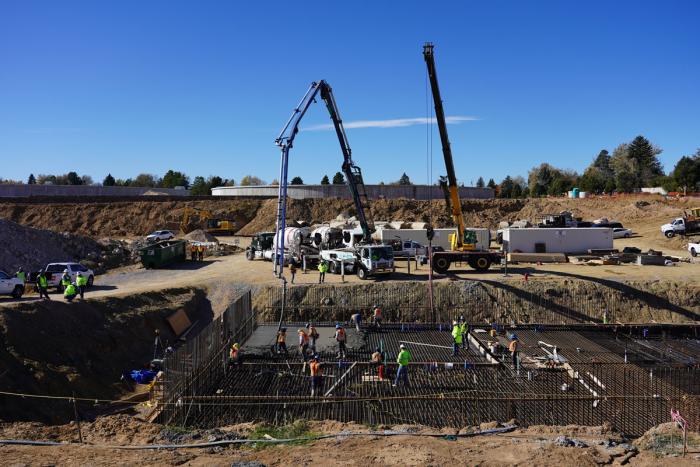$108 Million Renovation Project Wrapping Up
By Jay Adams
Big, new storage tanks and powerful pump station serve at critical water hub.
The water is flowing, the big tanks are filling, and the new pumps are humming at one of Denver Water’s most important facilities.
The Hillcrest water storage facility near Interstate 25 and East Quincy Avenue was built in the late-1950s and early-1960s to store and distribute water for the growing southeastern side of the Denver metro area.
The site included a pump station and two large tanks to store clean water from Denver Water’s Foothills and Marston treatment facilities on the west side of the metro area. Water from the tanks was sent out to customer homes, schools and businesses.
In 2016, Denver Water launched a $108 million renovation at Hillcrest. Primary renovations were completed in 2023 and wrap-up work, such as landscaping, is expected to be done by the end of September.
“Hillcrest is like the heart of our water distribution system by providing reliable water service to major extremities of the Denver Water service area,” said Paul Ries, Denver Water’s design project manager of the Hillcrest pump station replacement project.

Construction on the original water storage tanks at Hillcrest in 1959. Photo credit: Denver Water.
While the facility is in a great location to serve customers, the site has a history of soil movement, which led to structural damage and leaks to the storage tanks and pump station.
Due to those factors — and a need to improve the reliability and resiliency of water supplies for customers in the southeast metro area — Denver Water embarked on a plan to renovate and upgrade the Hillcrest infrastructure in 2016.
The project included building three, new, 15-million-gallon treated water storage tanks as well as a new pump station with 10 pumps. The new pump station also has the capacity to add two more pumps in the future.
The first storage tank was completed in 2018. All three new storage tanks were up and running by 2020. The new pump station began operations in 2022.

Construction workers place concrete on the roof of one of the new treated water storage tanks in 2017. Photo credit: Denver Water

Construction work on the new Hillcrest pump station in 2019. Photo credit: Denver Water.
Importance Of The Hillcrest Pumps
The Hillcrest facility primarily serves southeast Denver, Centennial, Greenwood Village, Lone Tree and even out to Denver International Airport. These locations can be served using gravity alone because of Hillcrest’s comparatively higher elevation.
However, there are times when the Hillcrest pumps are needed, such as when additional water pressure for customers is needed or when maintenance is conducted at other Denver Water facilities and pipelines.
The pumps also are used to send water to other treated water storage tanks in the southern part of the Denver Water service area.

The new Hillcrest pump station began operations in 2022. Photo credit: Denver Water.
“There are 10 pumps at Hillcrest, the largest of which is a 1,500-horsepower motor that operates at 4,160V,” said Nisha Nelson, Denver Water’s electrical engineer for the pump station project. “We have redundancy built into our system to ensure that we can meet the water demands of our customers during the hot summer months."

Denver Water’s electrical engineer on the Hillcrest pump station project, stands in the new Hillcrest pump station. Photo credit: Denver Water.

The new Hillcrest site has 10 pumps that push water through pipes buried under city streets. Photo credit: Denver Water.
Hydropower At Hillcrest
The Hillcrest site also generates power, using a hydropower turbine installed in 1994. No renovations to the turbine or powerhouse were part of the scope of the renovation project. However, the water pipe, power and controls connections from the turbine to the pump station and water storage tanks were replaced.
The hydropower turbine can produce up to 2 megawatts of electricity, which is roughly enough electricity to power around 2,000 homes, according to Phil Malone, water distribution manager at Denver Water.
“When we bring water down from our Foothills Treatment Plant there’s a lot of pressure,” Malone said.
“During high-demand season in the summer, we can run around 100 million gallons of water a day through the hydro and use the power of that water to create clean energy.”
Denver Water has the option to use the electricity generated by the turbine to power Hillcrest’s pumps or sell the power to Xcel Energy.

The Hillcrest hydropower turbine can produce up to 2 megawatts of electricity. Hillcrest is an ideal location for a hydropower unit because of the large amount of water that flows through the facility. Photo credit: Denver Water.
Denver Water has 31 treated water storage tanks across the metro area. Eight of them have undergone renovation since 2011. The utility also has 18 pump stations including Hillcrest.
The renovation work is part of Denver Water’s ongoing efforts to upgrade its infrastructure to ensure safe and reliable water to the 1.5 million people the utility serves in the metro area.
